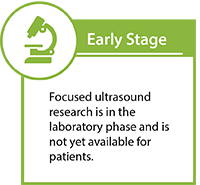Focused Ultrasound Therapy
Focused ultrasound is a noninvasive, therapeutic technology with the potential to improve the quality of life and decrease the cost of care for patients who have myocardial electrical dysfunction, and therefore need cardiac pacing. This novel technology focuses beams of ultrasound energy precisely and accurately on targets deep in the body without damaging surrounding normal tissue.
How it Works
Targeting the left ventricle and septum with focused ultrasound will cause myocardial contractions. This technique has been demonstrated in both small and large animals, indicating that perhaps future pacing may be accomplished noninvasively with focused ultrasound.
Advantages
The primary options for treatment of myocardial electrical dysfunction include medication and/or invasive procedures.
For certain patients, focused ultrasound could provide a noninvasive alternative to surgery with less risk of complications – such as surgical wound healing or infection – at a lower cost. Focused ultrasound can also reach the desired target without damaging surrounding tissue, and it can be repeated, if necessary.
Clinical Trials
At the present time, there are no clinical trials recruiting patients for focused ultrasound cardiac pacing.
Regulatory Approval and Reimbursement
Focused ultrasound treatment for cardiac pacing is not yet approved by regulatory bodies or covered by medical insurance companies.
Notable Papers
Yao Y, Qian J, Rong S, Huang Y, Xiong B, Yang G, Zhang D, Deng S, Tan J, Zhu Q, Deng C, Liu D, Ran H, Wang Z, Huang J. Cardiac Denervation for Arrhythmia Treatment with Transesophageal Ultrasonic Strategy in Canine Models. Ultrasound Med Biol. 2019 Feb;45(2):490-499. doi: 10.1016/j.ultrasmedbio.2018.10.013. Epub 2018 Dec 6.
Jang KW, Tu TW, Nagle ME, Lewis BK, Burks SR, Frank JA. Molecular and histological effects of MR-guided pulsed focused ultrasound to the rat heart. J Transl Med. 2017 Dec 13;15(1):252. doi: 10.1186/s12967-017-1361-y.
Fabrice Marquet, Pierre Bour, Fanny Vaillant, Sana Amraoui, Rémi Dubois, Philippe Ritter, Michel Haïssaguerre, Mélèze Hocini, Olivier Bernus, and Bruno Quesson. Non-invasive cardiac pacing with image-guided focused ultrasound. Published online 2016 Nov 9. doi: 10.1038/srep36534
Reyes G, Ruyra X, Valderrama F, Jimenez A, Duran D, Perez E, Daroca T, Moya J, Ramirez U, Aldamiz G. High intensity focused ultrasound ablation for atrial fibrillation: results from the National Spanish Registry. Minerva Cardioangiol. 2016 Oct;64(5):501-6.
Kohut AR, Vecchio C, Adam D, Lewin PA. The potential of ultrasound in cardiac pacing and rhythm modulation. Expert Rev Med Devices. 2016 Sep;13(9):815-22. doi: 10.1080/17434440.2016.1217772.
Livneh A, Kimmel E, Kohut AR, Adam D. Extracorporeal acute cardiac pacing by high intensity focused ultrasound. Prog Biophys Mol Biol. 2014 Aug;115(2-3):140-53. doi: 10.1016/j.pbiomolbio.2014.08.007.
Click here for additional references from PubMed.

